story and photos by Kayte Deioma
When it comes to exploring a city’s nightlife, as a woman traveling alone I am more likely to choose a seat at the theatre than the bar or nightclub scene. I love to go out dancing with friends or a date, but if I go to a nightclub alone I usually feel, well, alone. But when a friend said that Frenchmen Street was a good place to go out on your own at night in New Orleans, I decided to check it out.
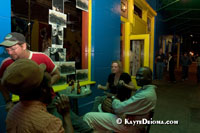 Unlike Bourbon Street, where you’ll find good music, but a great number of people are set on getting blitzed and there’s a certain sleaze factor, Frenchmen Street, located just outside the French Quarter in Faubourg Marigny, is all about the music. Although popular with locals, it has become a nightly haven for volunteers and relief workers to relax and unwind to good music after a hard day of gutting houses and trying to solve big problems. The half a dozen jazz clubs in a two block area, have a laid back bohemian feel.
Unlike Bourbon Street, where you’ll find good music, but a great number of people are set on getting blitzed and there’s a certain sleaze factor, Frenchmen Street, located just outside the French Quarter in Faubourg Marigny, is all about the music. Although popular with locals, it has become a nightly haven for volunteers and relief workers to relax and unwind to good music after a hard day of gutting houses and trying to solve big problems. The half a dozen jazz clubs in a two block area, have a laid back bohemian feel.
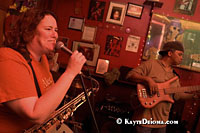 At small storefront establishments you can hear the music as well from the street out front as inside. With no cover charge, it’s easy to grab a seat or a corner of the bar to enjoy a solo drink and blend into the musical groove. At theApple Barrel I found Rebecca Barry and the FEMA No Checks, with Greg Madison on guitar and Sugar Bear on bass accompanying Rebecca’s vocals and sax. I recognized Sugar Bear from the Market Café that same morning where he had been playing with two other musicians. A couple doors down I found Sugar Bear’s morning compatriots, Pierre Pichon and Rafael Bas, playing with Java Swing at the Spotted Cat.
At small storefront establishments you can hear the music as well from the street out front as inside. With no cover charge, it’s easy to grab a seat or a corner of the bar to enjoy a solo drink and blend into the musical groove. At theApple Barrel I found Rebecca Barry and the FEMA No Checks, with Greg Madison on guitar and Sugar Bear on bass accompanying Rebecca’s vocals and sax. I recognized Sugar Bear from the Market Café that same morning where he had been playing with two other musicians. A couple doors down I found Sugar Bear’s morning compatriots, Pierre Pichon and Rafael Bas, playing with Java Swing at the Spotted Cat.
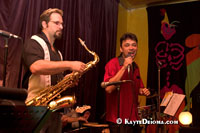 At Café Brasil on this Wednesday night, Fredy Omar con Su Banda were playing Latin jazz for fans spinning around the lightly crowded dance floor. I had met Omar a couple days before working at the Habitat for Humanity Musician’s Village building site. Omar was the first musician approved for a house at the site and he was putting in his sweat equity hours. Hanging out listening to the music, I recognized Habitat site supervisor Eli Grove. Some of the volunteers from Common Ground Relief were out on the dance floor. While New Orleans has always had a small town feel, the sparseness of the current population makes it that much more common to run into familiar faces when you’ve been in town a week.
At Café Brasil on this Wednesday night, Fredy Omar con Su Banda were playing Latin jazz for fans spinning around the lightly crowded dance floor. I had met Omar a couple days before working at the Habitat for Humanity Musician’s Village building site. Omar was the first musician approved for a house at the site and he was putting in his sweat equity hours. Hanging out listening to the music, I recognized Habitat site supervisor Eli Grove. Some of the volunteers from Common Ground Relief were out on the dance floor. While New Orleans has always had a small town feel, the sparseness of the current population makes it that much more common to run into familiar faces when you’ve been in town a week.
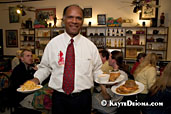 “Café Brasil is the incubator,” says Harold Toussant, a New Orleans native who waits tables at the Praline Connection, a New Orleans soul food restaurant across the street. “We know that every musician has a gift. Even if it is a little rough, people will be patient for them to develop the gift.” According to Toussant, those that have already polished their gift graduate to playing Snug Harbor, a block down and across the street. Snug Harboris known as the city’s premiere jazz club for up and coming artists as well as established names.
“Café Brasil is the incubator,” says Harold Toussant, a New Orleans native who waits tables at the Praline Connection, a New Orleans soul food restaurant across the street. “We know that every musician has a gift. Even if it is a little rough, people will be patient for them to develop the gift.” According to Toussant, those that have already polished their gift graduate to playing Snug Harbor, a block down and across the street. Snug Harboris known as the city’s premiere jazz club for up and coming artists as well as established names.
Frenchmen Street is located in Faubourg Marigny across Esplanade Avenue from the French Quarter. It meets Esplanade just below Decatur Street.

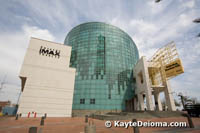 The Audubon Institute’s Aquarium of the Americas in New Orleans has been known as one of the top aquariums in the country since it first opened in 1990. The cylindrical glass building with its sharply angled roof managed to escape major harm from Hurricanes Katrina and Rita and avoided being flooded due to its position on the high banks of the Mississippi. But the power outage that followed the disaster and the failure of the backup generators caused heavy losses to the Aquarium’s sea life. After millions of dollars in repairs and restocking, the Aquarium reopened to the public at the end of May, 2006.
The Audubon Institute’s Aquarium of the Americas in New Orleans has been known as one of the top aquariums in the country since it first opened in 1990. The cylindrical glass building with its sharply angled roof managed to escape major harm from Hurricanes Katrina and Rita and avoided being flooded due to its position on the high banks of the Mississippi. But the power outage that followed the disaster and the failure of the backup generators caused heavy losses to the Aquarium’s sea life. After millions of dollars in repairs and restocking, the Aquarium reopened to the public at the end of May, 2006.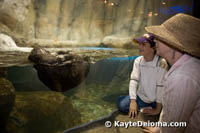 They were able to evacuate a few of the animals to other aquariums, so some familiar faces are back. The colony of African black-footed penguins and Rockhopper penguins survived, as well as the playful sea otters, Emma and Buck, and Mydas the giant green sea turtle.
They were able to evacuate a few of the animals to other aquariums, so some familiar faces are back. The colony of African black-footed penguins and Rockhopper penguins survived, as well as the playful sea otters, Emma and Buck, and Mydas the giant green sea turtle.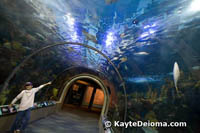 Other new additions were collected by the staff off the Florida Keys for the Caribbean Reef exhibit. TheCaribbean Reef Tunnel puts you under the sea amid intricate coral reefs teaming with life. Schools of fish and kite-shaped stingrays swim over and around you.
Other new additions were collected by the staff off the Florida Keys for the Caribbean Reef exhibit. TheCaribbean Reef Tunnel puts you under the sea amid intricate coral reefs teaming with life. Schools of fish and kite-shaped stingrays swim over and around you. Spots, the famous white alligator, still reigns over theMississippi River Gallery. He may lie so still that he looks stuffed, but the staff assures me that he starts getting active when he’s hungry. If you’re lucky, you might witness feeding time, but it only happens once or twice a week. The Mississippi River exhibit is also home to catfish, turtles, a red-tailed hawk, and an owl.
Spots, the famous white alligator, still reigns over theMississippi River Gallery. He may lie so still that he looks stuffed, but the staff assures me that he starts getting active when he’s hungry. If you’re lucky, you might witness feeding time, but it only happens once or twice a week. The Mississippi River exhibit is also home to catfish, turtles, a red-tailed hawk, and an owl.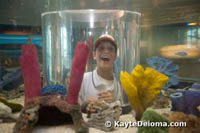 Brand new to the Aquarium in March 2007 is Adventure Island, with a touch pond of cownose rays and a children’s play area where kids can stick their head up in the middle of a fish tank, or climb inside a clam shell with a giant pearl.
Brand new to the Aquarium in March 2007 is Adventure Island, with a touch pond of cownose rays and a children’s play area where kids can stick their head up in the middle of a fish tank, or climb inside a clam shell with a giant pearl.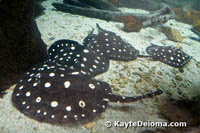
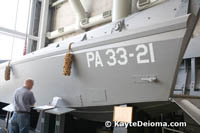 Higgins boats, also known as LCVPs (Landing Craft, Vehicle, Personel), are credited with allowing the allies to win World War II. They’re also the reason that you’ll find theNational World War II Museum in New Orleans. These amphibious vessels were modeled after the Eureka, a flat-bottomed boat designed by New Orleanian Andrew Jackson Higgins to navigate the swamps and bayous of Louisiana by reversing off land banks when they ran aground. The modified version, with a ramp to offload its cargo of one jeep and 12 soldiers, was one of half a dozen military vessels designed and built by Higgins Industries in New Orleans.
Higgins boats, also known as LCVPs (Landing Craft, Vehicle, Personel), are credited with allowing the allies to win World War II. They’re also the reason that you’ll find theNational World War II Museum in New Orleans. These amphibious vessels were modeled after the Eureka, a flat-bottomed boat designed by New Orleanian Andrew Jackson Higgins to navigate the swamps and bayous of Louisiana by reversing off land banks when they ran aground. The modified version, with a ramp to offload its cargo of one jeep and 12 soldiers, was one of half a dozen military vessels designed and built by Higgins Industries in New Orleans.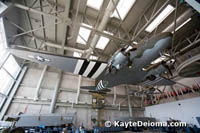 A replica of an LCVP, built according to the original plans, is on display in the Louisiana Memorial Pavilion at the National WWII Museum. The relatively small craft is overshadowed by the Douglas C-47 hanging overhead in the cavernous space. Other military vehicles on display in the Pavilion include a US tank, and jeeps, a German motorcycle and Howitzer, and a Supermarine Spitfire airplane from the British Royal Air Force.
A replica of an LCVP, built according to the original plans, is on display in the Louisiana Memorial Pavilion at the National WWII Museum. The relatively small craft is overshadowed by the Douglas C-47 hanging overhead in the cavernous space. Other military vehicles on display in the Pavilion include a US tank, and jeeps, a German motorcycle and Howitzer, and a Supermarine Spitfire airplane from the British Royal Air Force.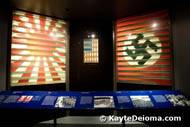 There’s a clear progression through the galleries. You begin with the build up to war and the imbalance of military forces. A graphic display using miniature soldiers against national flags shows how under-armed the American military was compared to the massive build up of forces in Germany and Japan. Even Italy had three times the military might of the U.S before the United States was forced into the war.
There’s a clear progression through the galleries. You begin with the build up to war and the imbalance of military forces. A graphic display using miniature soldiers against national flags shows how under-armed the American military was compared to the massive build up of forces in Germany and Japan. Even Italy had three times the military might of the U.S before the United States was forced into the war.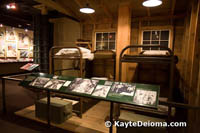 America Goes to War shows how the military buildup in America affected the people at home, from the implementation of the draft to women and minorities landing higher paying jobs in factories. Stacks of tires and piles of artillery shells demonstrate how sacrifices at home supplied the war effort. You can see the 1943 pennies made of steel so that the copper could be used for communication wire on the battle fields.
America Goes to War shows how the military buildup in America affected the people at home, from the implementation of the draft to women and minorities landing higher paying jobs in factories. Stacks of tires and piles of artillery shells demonstrate how sacrifices at home supplied the war effort. You can see the 1943 pennies made of steel so that the copper could be used for communication wire on the battle fields.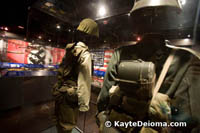 In the War in Europe section you can compare the uniforms of American and German soldiers as well as the weapons with which they were armed. You can also take a look inside a GI’s pockets to see what he would have been carrying, from his toothbrush and extra socks to shaving cream and toilet paper.
In the War in Europe section you can compare the uniforms of American and German soldiers as well as the weapons with which they were armed. You can also take a look inside a GI’s pockets to see what he would have been carrying, from his toothbrush and extra socks to shaving cream and toilet paper.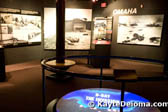 150,000 troops on the shores of Normandy in France on June 6, 1944 in what is now known as D-Day. This military reference to the undisclosed day an operation is to be implemented actually applies to every operation, but in common parlance, it refers to the execution of Operation Overlord. A tableau shows the density of ships and aircraft crossing the English Channel.
150,000 troops on the shores of Normandy in France on June 6, 1944 in what is now known as D-Day. This military reference to the undisclosed day an operation is to be implemented actually applies to every operation, but in common parlance, it refers to the execution of Operation Overlord. A tableau shows the density of ships and aircraft crossing the English Channel.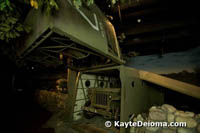 The strategy is laid out in personal stories of the assault by American, British and Canadian troops on five different French beaches. The stories of Omaha Beach, where American soldiers met the greatest German resistance, are accompanied by the compelling photos of the onslaught by the famous war photographer Robert Capa.
The strategy is laid out in personal stories of the assault by American, British and Canadian troops on five different French beaches. The stories of Omaha Beach, where American soldiers met the greatest German resistance, are accompanied by the compelling photos of the onslaught by the famous war photographer Robert Capa.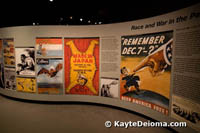 sides of the battle. Photos and stories illustrate the challenging physical conditions faced by soldiers and the heavy losses due to disease. A series of D-Day panels shows a timeline of D-Days for major operations in the Pacific theatre. TheAtom Bomb display is located at the bend in the hallway leading to Victory in the Pacific around the corner.
sides of the battle. Photos and stories illustrate the challenging physical conditions faced by soldiers and the heavy losses due to disease. A series of D-Day panels shows a timeline of D-Days for major operations in the Pacific theatre. TheAtom Bomb display is located at the bend in the hallway leading to Victory in the Pacific around the corner.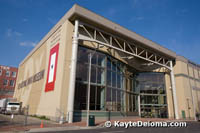 If you read everything and watch the videos, you could spend all day. There are plenty of exhibits that are relatively self-explanatory without reading all the informational panels if you’re pressed for time, or not a big museum reader. If you want to do the reading at home before you go, check out the history section of the museum’s website. It provides much of the information on the extensive exhibit panels. Then you can spend your museum time studying the artifacts and photos.
If you read everything and watch the videos, you could spend all day. There are plenty of exhibits that are relatively self-explanatory without reading all the informational panels if you’re pressed for time, or not a big museum reader. If you want to do the reading at home before you go, check out the history section of the museum’s website. It provides much of the information on the extensive exhibit panels. Then you can spend your museum time studying the artifacts and photos.